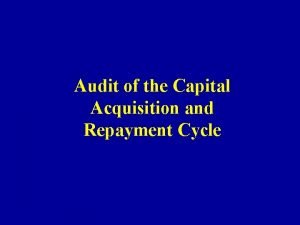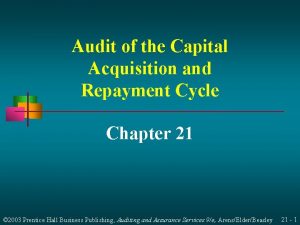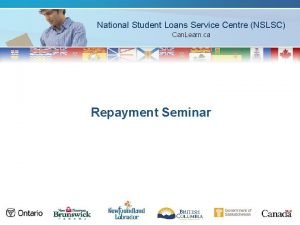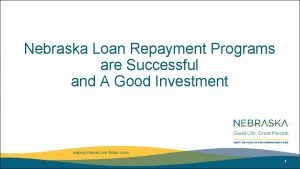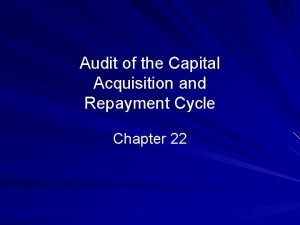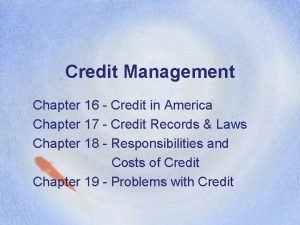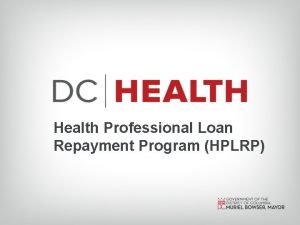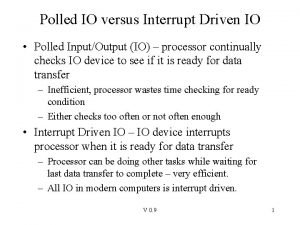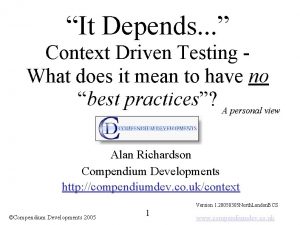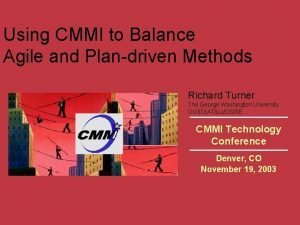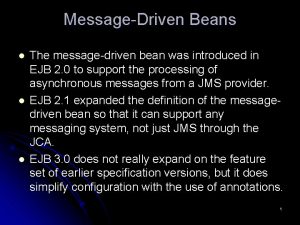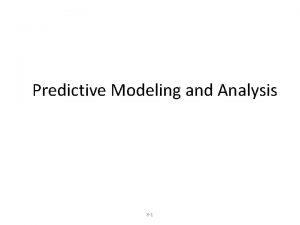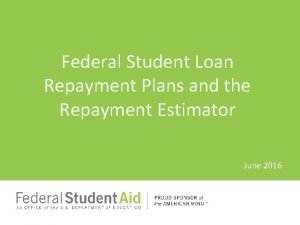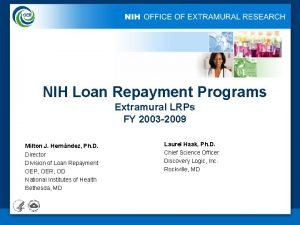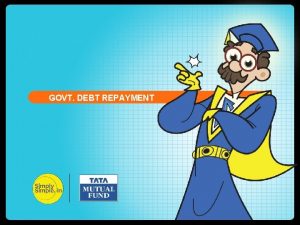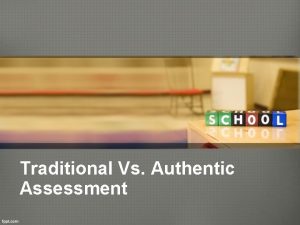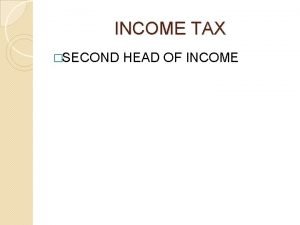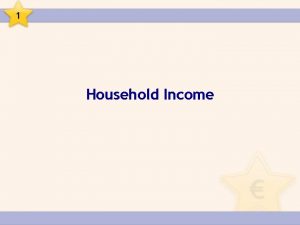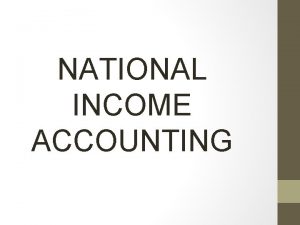Repayment Plans Income Driven plans vs Traditional Plans






















- Slides: 22

Repayment Plans: Income Driven plans vs. Traditional Plans Widener University

Agenda • Income-Driven Repayment Plans Overview – – – Pay As You Earn Plan Repaye Income-Based Repayment Plan Income-Contingent Repayment Plan Applying for an Income Driven Plan • Other Repayment Plans – Standard – Graduated – Extended (fixed or graduated) • Public Service Loan Forgiveness • Direct Loan Consolidation • Resources 2

Who Should Consider Income-Driven Repayment Plans? Borrowers with high student loan payments relative to income • Individuals who are experiencing financial difficulties but who may not qualify for other options such as deferment or forbearance • Teachers with heavy debt loads against low salaries • Individuals pursuing lower paid social-service careers • Recent graduates managing typical federal student loan debt in low-wage jobs or unpaid internships • Law graduates earning low salaries as public defenders • Medical residents earning typical resident salaries 3

Borrower Considerations Pros More manageable, lower monthly payment Repayment period could be more than 10 years Avoidance of delinquency and default More interest could be paid over time Remaining principal and interest is forgiven after 20 or 25 years of payments Required annual submission of information on income and family size to prove continued eligibility for reduced payments Possibility of Public Service Loan Forgiveness (after 10 years of qualifying payments) 4 Cons

Pay As You Earn • Who qualifies: – “New” borrowers who have a PFH • Has no outstanding balance on a Direct or FFELP loan as of 10/1/2007, or has no outstanding balance on a Direct or FFELP loan when he or she obtains a new loan on/after 10/1/2007 AND • Receives a disbursement of a Direct Subsidized or Unsubsidized Stafford, or Grad PLUS loan on or after 10/1/2011; or receives a Direct Consolidation Loan based on an application received on/after 10/1/2011 • Eligible Loans: – Direct Loans except: 5 • Defaulted loans • Parent PLUS loans • Consolidation loans that repaid Parent PLUS loans

Pay As You Earn • Under Pay As You Earn, borrowers pay the lesser of: – 10% of discretionary income or what they would have paid under the 10 -year Standard repayment plan. – Discretionary income for this plan is the difference between the borrower’s AGI and 150 percent of the poverty guideline amount for his/her state of residence and family size. • Interest subsidy benefit ‾ If the monthly Pay As You Earn payment amount does not cover the interest that accrues on the loans each month, the government will pay the unpaid accrued interest on the borrower’s Direct Subsidized Stafford Loans for up to three consecutive years from the date they began repaying under Pay As You Earn or IBR. • The three years does not include periods of Economic Hardship Deferment • Borrower must pay all interest on unsubsidized loans • For Pay As You Earn, the remaining balance is forgiven after 20 years of qualifying repayment 6

Income-Based Repayment (IBR) • Under IBR, borrowers pay the lesser of: – 15% of discretionary income or what they would have paid under the 10 -year Standard repayment plan (Not a new borrower on/after 7/1/2014) – 10% of discretionary income or what they would have paid under the 10 -year Standard repayment plan (New borrowers only on/after 7/1/2014) – Discretionary income for this plan is the difference between the borrower’s Adjusted Gross Income (AGI) and 150 percent of the poverty guideline amount for his/her state of residence and family size. • Interest subsidy benefit – If the monthly IBR payment amount does not cover the interest that accrues on the loans each month, the government will pay the unpaid accrued interest on the borrower’s Subsidized Stafford Loans (either Direct Loan or FFEL Loans) for up to three consecutive years from the date they began repaying under IBR or Pay As You Earn. • The three years does not include periods of Economic Hardship Deferment • Borrower must pay all interest on unsubsidized loans • Loan forgiveness 7 – If the borrower makes 25 years of qualifying payments and meets certain other requirements, any remaining balance will be cancelled (20 years for new borrowers only on/after 7/1/2014)

IBR Payment Amounts The IBR Partial Financial Hardship (PFH) payment amount is determined by the AGI and family size • If the borrower is married and files a joint federal tax return, the AGI includes both spouse’s incomes together • If the spouse has eligible student loan debt, this debt may also be taken into consideration when determining whether the borrower has a PFH • Annual IBR repayment amount is 15% of the difference between the borrower’s AGI and 150% of the Department of Health and Human Services Poverty Guideline for their family size and state The IBR payment amount will be adjusted yearly based on income and family size but will never be more than what would be required to be paid under a 10 year Standard Plan based on the balance of the eligible loans when the borrower began repayment under the IBR plan 8

IBR Payment Amounts EXAMPLE: Borrower’s AGI is $50, 000 and they reside in 1 of the 48 contiguous states and a family size of 1. – Poverty guideline for this example is $11, 770 x 150% = $17, 655 – Then we subtract $17, 655 from $50, 000 = $32, 345 which is the discretionary income – $32, 345 x 15% = $4, 851. 75 and divide that figure by 12 = $404. 31 9

Leaving IBR/PAYE/REPAYE • If borrowers leave IBR/PAYE/REPAYE and have unpaid interest, it will capitalize to principal, increasing principle balance • The borrower is placed into the Standard Plan or alternative plan (Repaye) based on the term remaining for their loan type – For example, Stafford/PLUS Loans will have 10 years minus the time in repayment. Consolidation Loans may have 10 -30 years minus the time in repayment. – Borrowers may request a reduced payment forbearance if they cannot afford the payment amount on the standard repayment plan. • Borrowers who leave IBR/PAYE can come back if they demonstrate "partial financial hardship". 10

Income-Contingent Repayment (ICR) • Does not require borrower to show PFH for eligibility • Loan discharged after 25 years • Each year the monthly payments are recalculated based on: – AGI (spouse’s income will only be included if they file federal taxes jointly or are repaying under joint ICR – The Family size – Total amount of the borrower’s Direct Loans – Lesser one of the following: • 12 -year standard repayment schedule multiplied by income percentage factor, or • 20 percent of discretionary income • If payments are not large enough to cover the interest that accrues monthly, the unpaid interest is capitalized once each year – The amount capitalized will not exceed 10% of original amount owed when the borrower entered repayment – If the borrower’s payments are not enough to cover the accruing interest, it will continue to accrue but will not be capitalized if the borrower has reached the 10% limit 11

Income-Driven Repayment Application 17 • Borrowers may apply for an IDR on www. studentloans. gov or complete a paper application. • Can be used by borrowers with Direct Loans or FFEL Loans • Uses IRS Data Retrieval Tool that is used on the FAFSA • Retrieves the most recent tax information from two most recently completed tax years • If a borrower selects a specific repayment plan that they are not eligible for, the borrower will be placed on the lowest monthly payment amount IDR plan for which they are eligible.

Standard & Graduated Repayment Plans Standard Repayment • • Assigned to borrowers automatically unless otherwise specified Fixed (equal) payment amount each month, although it could vary due to interest rate changes on a variable rate loan Monthly payments will be at least $50 10 -year repayment term (Standard Repayment for Direct Consolidation loans is 10 to 30 years based on balance) Graduated Repayment • • 19 Payments start low and generally increase every two years 10 -year repayment term (Direct Consol. Loans may have a term of 10 to 30 years based on balance) Monthly payment is never less than the amount of interest that accrues each month No single payment will be more than three times greater than any other payment

Extended Repayment Plan Extended Repayment • Will pay a fixed or graduated payment amount • Repayment term not to exceed 25 years • FFEL borrowers must have more than $30, 000 in outstanding FFEL Program loans (for new borrowers as of 10/07/1998) • Direct borrower must have more than $30, 000 in outstanding Direct Loans (for new borrowers as of 10/07/1998) 20 Examples from studentaid. ed. gov calculators

Exit Counseling Repayment Plan Selection 21 • In January, the Department began sharing the borrower’s repayment plan preference from Exit Counseling on www. Student. Loans. gov with the federal loan servicers and Federal Family Education Loan (FFEL) Program lenders, lender servicers, and guaranty agencies. • Repayment plan selection will be considered by the servicer, and – if possible, applied to the borrower’s account.

Student. Loans. gov Repayment Plan Comparison Calculator The Repayment Estimator on Student. Loans. gov takes a student’s current loan balance and shows what her monthly and total payments would be using various repayment plans. Borrowers can use the repayment estimator tool during Exit Counseling or the Financial Awareness Counseling Tool. 22

Repayment Schedule Estimators Check out the Repayment Estimators available at Fed. Loan Servicing and Student. Loans. gov 23

Public Service Loan Forgiveness (PSLF) 10 years The borrower may qualify for loan forgiveness earlier than 25 years (20 years if under Pay As You Earn) if they work full-time for a qualifying public service organization and make on-time full monthly payments under the repayment plans listed below. Payments made under these plans will count toward the 120 monthly payments that are required to receive loan forgiveness through PSLF. • • • 10 -year Standard Repayment Plan Income Based Repayment (IBR) Plan Income-Contingent Repayment (ICR) Plan Pay As You Earn Plan Any other repayment plan if the monthly payment amount is paid is not less than what would have been paid under the 10 -year Standard repayment plan For more information on PSLF, please refer to the PSLF Fact Sheet and Q&As: www. studentaid. ed. gov/publicservice 24

Direct Loan Consolidation Direct Loan consolidation allows borrowers to combine or more existing student loans into a single new loan. Consolidation may be the right option for your borrower if: • If student loan debt is significant. • If borrower has more than one type of student loan. • Has trouble making the minimum monthly payments on multiple loans. Pros 25 Cons Lower monthly payments Longer repayment schedule Fixed interest rate More interest to pay One bill, one payment Loss of loan incentives

Servicing Resources Contact Information for Borrowers Contact Information for Schools Servicer 26 Phone Website Fed. Loan Servicing 1 -800 -699 -2908 My. Fed. Loan. org 1 -800 -655 -3813 My. Fed. Loan. org/schools Great Lakes 1 -800 -236 -4300 My. Great. Lakes. org 1 -888 -686 -6919 My. Great. Lakes. org Nelnet 1 -888 -486 -4722 Nelnet. com 1 -866 -463 -5638 Nelnet. com Navient 1 -800 -722 -1300 Navient. com 1 -888 -272 -4665 Navient. com NSLDS 1 -800 -999 -8219 NSLDS. gov 1 -800 -999 -8219 nsldsfap. ed. gov/nslds_FAP/

Additional Resources • Income-Driven Repayment Plans: Frequently Asked Questions • Repayment Schedule Estimator • Repayment Options • Repayment Calculators • Federal Student Aid (FSA) Repayment Information • Department of Health and Human Services Poverty Guidelines - 2015 • Repayment Plan Preference Info Shared w/ Loan Servicers https: //studentaid. ed. gov/sa/sites/default/files/income-driven-repayment-q-and-a. pdf www. myfedloan. org/billing-payment/payment-plans/repayment-schedule-estimator. shtml www. myfedloan. org/billing-payment/payment-plans/index. shtml http: //studentaid. ed. gov/repay-loans/understand/plans http: //www. finaid. org/calculators/ http: //www. myfedloan. org/make-a-payment/calculators/index. shtml www. studentaid. ed. gov/PORTALSWeb. App/students/english/repaying. jsp http: //aspe. hhs. gov/poverty/15 poverty. cfm http: //ifap. ed. gov/eannouncements/102813 LSIRepay. Plan. Info. Loan. Sevicers. Begin. Jan 2014. html 27

 How to calculate real gdp per capita
How to calculate real gdp per capita Deferred tax asset journal entry
Deferred tax asset journal entry Income statement multi step
Income statement multi step Loss contingency journal entry
Loss contingency journal entry Traditional income statement
Traditional income statement Acquisitions and payments cycle
Acquisitions and payments cycle Capital acquisition and repayment cycle
Capital acquisition and repayment cycle National student loans service centre nslsc
National student loans service centre nslsc Rumus repayment capacity
Rumus repayment capacity Nebraska loan repayment program
Nebraska loan repayment program Absa prime rat
Absa prime rat Capital acquisition and repayment cycle
Capital acquisition and repayment cycle Property pledged to assure repayment of a loan
Property pledged to assure repayment of a loan Hplrp
Hplrp Memory driven computing
Memory driven computing Polled i/o
Polled i/o Context driven testing
Context driven testing Using risk to balance agile and plan driven methods
Using risk to balance agile and plan driven methods Student-driven synonym
Student-driven synonym Next generation soc
Next generation soc Lll beans
Lll beans Service driven
Service driven Logic driven model
Logic driven model





